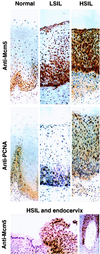Improved cervical smear assessment using antibodies against proteins that regulate DNA replication
- PMID: 9843993
- PMCID: PMC24553
- DOI: 10.1073/pnas.95.25.14932
Improved cervical smear assessment using antibodies against proteins that regulate DNA replication
Abstract
Carcinoma of the cervix is one of the most common malignancies. Papanicolaou (Pap) smear tests have reduced mortality by up to 70%. Nevertheless their interpretation is notoriously difficult with high false-negative rates and frequently fatal consequences. We have addressed this problem by using affinity-purified antibodies against human proteins that regulate DNA replication, namely Cdc6 and Mcm5. These antibodies were applied to sections and smears of normal and diseased uterine cervix by using immunoperoxidase or immunofluorescence to detect abnormal precursor malignant cells. Antibodies against Cdc6 and Mcm5 stain abnormal cells in cervical smears and sections with remarkably high specificity and sensitivity. Proliferation markers Ki-67 and proliferating cell nuclear antigen are much less effective. The majority of abnormal precursor malignant cells are stained in both low-grade and high-grade squamous intraepithelial lesions. Immunostaining of cervical smears can be combined with the conventional Pap stain so that all the morphological information from the conventional method is conserved. Thus antibodies against proteins that regulate DNA replication can reduce the high false-negative rate of the Pap smear test and may facilitate mass automated screening.
Figures




References
-
- Cancer Research Campaign. Cancer of the Cervix Uteri, Fact Sheet 12. London: CRC; 1994.
-
- Cancer Research Campaign. Cancer: World Perspectives, Fact Sheet 22. London: CRC; 1995.
-
- Park, T. W., Fujiwara, H. & Wright, T. C. (1995) Cancer 76, Suppl., 1902–1913. - PubMed
-
- Wright T C, Ferenczy A F, Kurman R J. In: Blaustein’s Pathology of the Female Genital Tract. Kurman R J, editor. New York: Springer; 1994. pp. 229–278.
-
- Wright T C, Kurman R J. In: Papillomavirus Reviews: Current Research on Papillomaviruses. Lacey C, editor. Leeds: Leeds Univ. Press; 1996. pp. 215–225.
Publication types
MeSH terms
Substances
Grants and funding
LinkOut - more resources
Full Text Sources
Other Literature Sources
Medical
Research Materials

